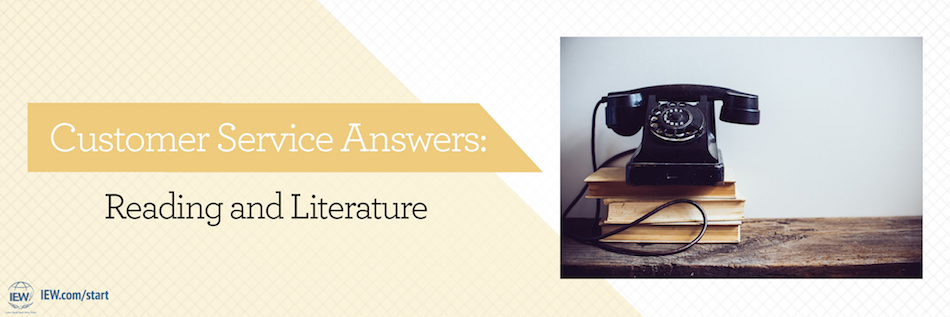
As you begin to plan for the upcoming school year, you may have questions about what types of products IEW offers that focus on literature. This post will help you identify and clarify which products will work for your students’ needs. Enjoy reading through it, and get ready to have a fabulous year of enjoying literature with your students!
What are the differences between Teaching the Classics, Windows to the World, and Timeline of Classics?
Windows to the World is an introductory course to literary analysis. If you utilize A Syllabus for Introduction to Literary Analysis, a free download when you purchase the Windows course, you can pair it with Teaching the Classics to provide a full year of literature and literary analysis.
Teaching the Classics and Timeline of Classics are both resources created to aid teachers on their voyages into literature with their students. Teaching the Classics explains to the teacher how to introduce plot, character, theme, setting, and literary elements to students of all ages. This is a DVD course that teachers along with high school students can go through as slowly or as quickly as they need.
Timeline of Classics is a chronological index of world history as viewed through literature. Journeying back to 5000 BC, you can read literature about Egyptian civilization and continue on to witness the unfolding of history until modern times through classic literary pieces. Timeline of Classics also includes instruction on Reader-Response Journaling, enabling students to outline each chapter they read to strengthen comprehension and develop discernment as they experience the classics.
What are the differences between How to Write a Story and Guide to Writing your Novel?
How to Write a Story is an appropriate curriculum for aspiring middle school or high school short story writers. Focusing on what makes an intriguing, well-organized work, How to Write a Story teaches a student the entire writing process from generating ideas to developing their plot. Providing a solid understanding of what makes an effective short story, this curriculum is an expansion of IEW’s Unit 3: Retelling Narrative Stories and includes direction on how to include character development, explore themes, and more.
Taking How to Write a Story one step further, A Guide to Writing Your Novel, intended for high school and college students, aids the ambitious writer in becoming a published novelist. Explaining how critical the beginning of a novel is, Lee Roddy, the author, describes the key elements that go into developing a suspense, mystery, romance, or juvenile plot in order to generate a page-turning book.
Do you offer anything to help with reading and/or reading comprehension?
IEW’s primary focus is the art of writing; however, we do offer a few reading resources: Timeline of Classics and Linguistic Development through Poetry Memorization.
Timeline of Classics not only provides you with a chronological list of books to choose from, but also notes whether a book is appropriate for elementary, middle, or high school. Providing you with numerous options to choose from, Timeline of Classics will give your student a variety of literature to read as well as ideas for journaling about new vocabulary and literary devices.
Giving students a fun, engaging vehicle to learn vocabulary, syntax, and many great poems, Linguistic Development through Poetry Memorization has four levels of poems, ranging from a few sentences to a few paragraphs as well a level dedicated to great speeches in history. As students go through through this curriculum, memorizing poetry with the aid of CDs, they soon begin to expand their understanding of complex sentences and ideas, which aids the students in strengthening their comprehension.
What are the differences between the old and new editions of Teaching the Classics?
Without changing its methodology Teaching the Classics was re-filmed using high-quality video and audio. Additionally the syllabus notebook was expanded to include more helpful explanations, discussions, and teacher tips. Below are some of the main features that are now included in Teaching the Classics:
• line-by-line explanations of each question on the Socratic List
• extended discussions of teaching philosophy and techniques
• additional tips for teachers on lesson planning and scope and sequence development
• a live “FAQ” discussion addressing common teacher questions
• live readings of classic stories with first edition illustrations by the original artists
A 120-page syllabus notebook features 25 pages of additional content:
• expanded discussion notes for each DVD session
• a reorganized Socratic List of discussion questions
• a revised bibliography of recommended books for students of all ages
• expanded lists of literary devices, terms, and definitions
• links to new supplemental resources designed for the Teaching the Classics method
Do you have any lists of books you recommend? Where do I find good literature? Fiction? Novels? Trilogies?
IEW’s Books for Boys & Other Children Who Would Rather Make Forts All Day is an ongoing list of literature and related resources for parents and teachers that has numerous books for all ages, interests, and aptitudes. Among the many books this list includes books for grades K–12, including The Wind in the Willows by Kenneth Grahame, The Hardy Boys Series by Franklin W. Dixon, Michelangelo by Diane Stanley, and Journey to the Center of the Earth by Jules Verne. Additionally, visit this IEW blog post that lists audiobook recommendations as well as different audiobook sources such as Audible and Librivox.
We hope this post has answered your questions about the variety of literature products we offer. If you find that you have more questions, we welcome you to contact our office. We are always very happy to help you find the perfect resource for your classroom or family!
